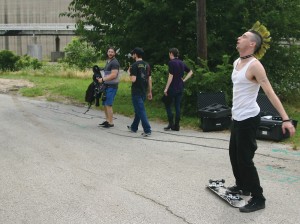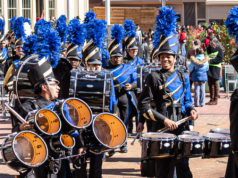The weary working-class neighborhood near Allen Street and I-35 made an ideal stand-in for an equally run-down neighborhood in Amarillo circa 1997. Movie producer Sheldon Chick was among the two-dozen film crewmembers who had lighted down on Fort Worth’s St. Louis Avenue last week, making a small frame home resemble the abode of Brian Deneke, a 19-year-old punk rocker who was killed by a 17-year-old high school football player almost 20 years ago. The movie is based on a true story.

Chick grew up in Amarillo and laments that the murder and subsequent lack of jail time for the killer never got enough national attention. His Bomb City is named after the punk rock gang that developed a deadly rivalry with football players in small town Texas.
Chick was quick to answer when asked why he didn’t shoot the film in his hometown where the murder happened.
“The wind, the lack of crew, the hotel expenses,” he said.
He moved to Dallas 10 years ago and has based his film work there ever since. He’s worked mostly as a writer, producer, composer, and actor in short films such as Behold the Noose (2014), a horror film set in Kaufman County. The people he chooses to work with live around Dallas. Filming in Amarillo would have meant putting up all those workers in hotels, adding thousands of dollars to the budget.
Finding locations to film scenes is part of a producer’s job. Chick ended up selecting the Fort Worth neighborhood because it had the right look, emphasized by a large abandoned grain elevator looming nearby.
“We just love this neighborhood because of the backdrop,” he said.
The mostly Hispanic residents of the neighborhood either ignored the moviemaking going on in their midst or stood in their yards and stared quizzically. A woman who lived next door to the house where a scene was being filmed had gone outside to sweep her sidewalk. She wanted to make a good impression for the filmmakers, not quite understanding the importance of continuity. (A dirty sidewalk that suddenly becomes clean mid-scene might confuse viewers.)
Another woman stood in her driveway across the street and watched Porter and his crew set up camera equipment. I asked her what she thought about a movie being made in her midst, but she didn’t speak English. She went inside her house to fetch her husband. A sleepy looking man with disheveled hair stumbled into the clammy morning to see what I wanted. He seemed slightly perturbed at being awakened for such a mundane question about a movie.
“That’s entertainment,” he said, going back inside to finish his nap.
Yes, it’s entertainment, and that means money.
City leaders were convinced that a single point of contact for filmmakers would attract more projects and put money in the pockets of locals. The Motion Picture Association of America cites the movie and TV industry as a major private sector employer, supporting almost 2 million jobs and $111 billion in wages in 2012. Direct industry jobs –– those involved in producing, marketing, and distributing –– enjoy salaries more than 40 percent higher than the national average. And most productions will spread the wealth to various caterers, dry cleaners, car rentals, digital equipment providers, and various other local companies.
By comparison, the U.S. steel industry produced about 90 million tons of steel shipments valued at $75 billion in 2014, according to the American Iron and Steel Institute.
The international film commission estimates that a feature film production –– something that Fort Worth generally misses out on –– generates about $2 million a week toward the local economy during a shoot.
Dallas has created more than 18,000 production jobs since 2012. The state has created about 65,000 production jobs during that time. Many of those jobs can be traced back to a film commission’s involvement.
“A film commission is paramount,” Chick said. “For someone who wants to film in Fort Worth, the commission is someone on your side.”
Christopherson was already involved somewhat in helping filmmakers. When producers were unable to find a local film commission, they would often call the Visitors Bureau for help and end up talking to her. She was helpful. They liked her. She seemed like the logical choice to head up the commission after it became official last October.
Since then, Christopherson and her marketing VP Whitten have assisted in 40 film projects.
“It has been a variety of commercials, reality shows, independent films, and industrial corporate videos,” Christopherson said.
The goals for the first year include raising money to pay for the commission’s costs and to attend statewide marketing events to spread the word about Fort Worth’s new welcome mat for filmmakers. Christopherson’s bunch is partnering with the Lone Star Film Festival to create the My Fort Worth Film Competition, which will showcase original short films, music videos, documentaries, and animated shorts. And she is partnering with TCU students for production boot camps.
A recent reality show taping resulted in 40 hotel rooms booked for eight nights, while a TV commercial saw 30 hotel rooms booked for a week. The film commission tracks this kind of information and releases an annual report showing how the city has benefited. Film producers will report on how many people they hired, how many cars and hotels they rented, and how much money they spent on locations, services, and supplies.
“By year two, we will have the ability to paint a picture of what that looks like,” she said.
Some projects, such as commercials and documentaries, can raise awareness of the city by featuring Sundance Square, the Stockyards, the Cultural District, and other local hot spots. Other projects, like the indie flick Bomb City, don’t laud Fort Worth. (Moviegoers will think they’re seeing scenes in Amarillo.) But those kinds of projects boost the local economy.
“We want to work with all types,” Whitten said. “The economic impact is the top priority. If a filmmaker is deciding to come here, time is money, and we try to provide very quick responses to them.”
The film people feel a kindred spirit in Christopherson, who worked in the industry before joining the Convention and Visitors Bureau in 2011. She was a producer at Fox Broadcasting Co. both locally and in Los Angeles. Filmmakers feel reassured by someone who has stood in their shoes.
“Speaking their language and being able to understand their needs is a big step forward,” Whitten said.
The biggest push so far seems to be compiling an online list of locations. It’s more involved than it sounds. The Stockyards, Panther Island, Sundance Square, and other public places sometimes have unique restrictions in addition to the city’s permits and requirements. The film commission figures all that out in advance so filmmakers don’t have to recreate the wheels themselves. The list of locations can never be too big. Malls, rich homes, poor homes, jails, baseball fields, ranches, offices, playgrounds, rivers, skyscrapers –– all these locations are ripe for the plucking.
“You never know what somebody will be looking for,” Christopherson said.
******












Thank you for the story, Jeff. We look forward to more film projects and Jessica is doing a bang-up job!